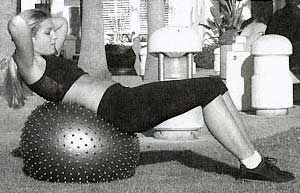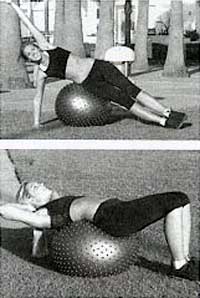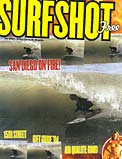SURFSHOT MAGAZINE By Paul Frediani
Having a strong and stable core is an essential to the well-being, health and performance of surfers, not only in the water but also for everyday functional activities.
Photo: John EckertThe core consists of the abdominals and the lower back. Like cables of a bridge, the core must be strong to maintain the integrity and stability of the trunk. It is the kinetic (muscular movement) link that connects and stabilizes the movements between hips and shoulders. Static stability is the ability to remain in one position for a period of time without losing postural alignment. Dynamic stability, as in surfing, is the ability to keep all working joints in proper alignment during any movement so that such movement is efficient.

The core is also the center of power (think of Sunny Garcia's ripping turns); furthermore it's where the center of gravity is located. A strong core plays a crucial role in having good balance and equilibrium, thus enabling quicker and smoother transitions from one maneuver to another.
Core strength is more than having a "six-pack" for abs. The abdominals are involved in respiration and and in providing intra-abdominal pressure thus protecting the spine and the lower back. Having a strong core is optimal for good posture and having good posture will reduce injuries and wear and tear of your joints. All this adds up to more time in the water!
To train the core properly we need a basic understanding of the anatomy and function of the abdominals and the lower back musculature.

The abdominal unit is made up of four muscle groups. The rectus abdominis, the external oblique, internal oblique and the transverse. The rectus abdominis is the most superficial of the abdominal muscles. It is the muscle that can be easily identified with indivuals that have low body fat. The primary function of the rectus is forward flexion and stabilization of the spine when in extension. A strong rectus helps ease pressure of the lower back when paddling. The external oblique is the largest of the abdominal muscles. It rotates the trunk to the opposite side and is anchored by the opposing internal oblique when doing so. The internal oblique is also responsible for side flexion. Surfing being a rotational sport it is important to keep both internal and external obliques strong. Deeply seated beneath all these muscles is the transverse abdominis. It is the major stabilizer of the lumbar spine; acting like the body's natural weight belt.
The back muscles, known as the erector spinae group muscle group (spinalis, longisimus, and iliocostalis), counterbalance the forward flexion of the abdominal musculature and are responsible for extension and side flexion of the spine. No core strength program is complete without training them. At least one third of core exercises should consist of back extension exercises. If one ignores the erectors while strengthening the abdominal they will be encouraging poor posture.
Why Use the Swissball?
Using the Swissball is ideal for training the abs. Its unstable and round surface allow for a greater degree of extension before going into flexion. This can't be done while lying on the floor. This added movement trains the muscles in their full range of motion in which they are created. A fuller range of motion will recruit and activate more muscle fiber thus preparing the trunk musculature for whatever chaotic and unexpected movements that may be required when surfing.Get a copy of Paul Frediani's Surf Flex book! Send us your surf health question to editor@surfshot.com and Paul will answer them. Selected questions will win a copy of this great book!


